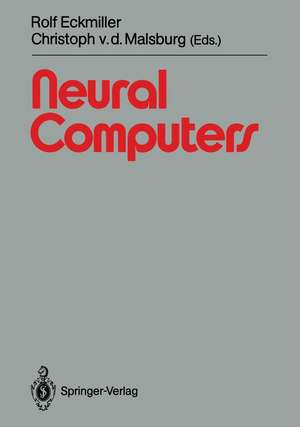Neural Computers: Springer Study Edition
Editat de Rolf Eckmiller, Christoph v. d. Malsburgen Limba Engleză Paperback – 30 mar 1989
Din seria Springer Study Edition
-
 Preț: 386.26 lei
Preț: 386.26 lei -
 Preț: 370.79 lei
Preț: 370.79 lei -
 Preț: 296.06 lei
Preț: 296.06 lei -
 Preț: 403.37 lei
Preț: 403.37 lei -
 Preț: 508.91 lei
Preț: 508.91 lei - 23%
 Preț: 921.30 lei
Preț: 921.30 lei -
 Preț: 403.37 lei
Preț: 403.37 lei -
 Preț: 389.70 lei
Preț: 389.70 lei - 15%
 Preț: 502.73 lei
Preț: 502.73 lei -
 Preț: 389.70 lei
Preț: 389.70 lei - 5%
 Preț: 1122.94 lei
Preț: 1122.94 lei - 5%
 Preț: 370.38 lei
Preț: 370.38 lei -
 Preț: 406.25 lei
Preț: 406.25 lei - 15%
 Preț: 530.58 lei
Preț: 530.58 lei -
 Preț: 398.35 lei
Preț: 398.35 lei - 5%
 Preț: 368.73 lei
Preț: 368.73 lei - 15%
 Preț: 633.02 lei
Preț: 633.02 lei -
 Preț: 392.75 lei
Preț: 392.75 lei - 15%
 Preț: 588.69 lei
Preț: 588.69 lei - 20%
 Preț: 660.99 lei
Preț: 660.99 lei - 15%
 Preț: 640.88 lei
Preț: 640.88 lei - 15%
 Preț: 654.43 lei
Preț: 654.43 lei -
 Preț: 390.46 lei
Preț: 390.46 lei - 15%
 Preț: 652.81 lei
Preț: 652.81 lei -
 Preț: 394.87 lei
Preț: 394.87 lei - 15%
 Preț: 642.03 lei
Preț: 642.03 lei - 15%
 Preț: 688.99 lei
Preț: 688.99 lei - 15%
 Preț: 642.36 lei
Preț: 642.36 lei - 15%
 Preț: 635.15 lei
Preț: 635.15 lei -
 Preț: 396.62 lei
Preț: 396.62 lei - 18%
 Preț: 893.21 lei
Preț: 893.21 lei -
 Preț: 419.14 lei
Preț: 419.14 lei -
 Preț: 423.34 lei
Preț: 423.34 lei - 20%
 Preț: 377.27 lei
Preț: 377.27 lei - 18%
 Preț: 742.97 lei
Preț: 742.97 lei - 15%
 Preț: 655.27 lei
Preț: 655.27 lei - 20%
 Preț: 336.02 lei
Preț: 336.02 lei -
 Preț: 397.38 lei
Preț: 397.38 lei
Preț: 663.61 lei
Preț vechi: 829.51 lei
-20% Nou
Puncte Express: 995
Preț estimativ în valută:
126.100€ • 137.90$ • 106.68£
126.100€ • 137.90$ • 106.68£
Carte tipărită la comandă
Livrare economică 23 aprilie-07 mai
Preluare comenzi: 021 569.72.76
Specificații
ISBN-13: 9783540508922
ISBN-10: 3540508929
Pagini: 584
Ilustrații: XIII, 566 p. 8 illus.
Dimensiuni: 170 x 242 x 31 mm
Greutate: 0.92 kg
Ediția:1989
Editura: Springer Berlin, Heidelberg
Colecția Springer
Seria Springer Study Edition
Locul publicării:Berlin, Heidelberg, Germany
ISBN-10: 3540508929
Pagini: 584
Ilustrații: XIII, 566 p. 8 illus.
Dimensiuni: 170 x 242 x 31 mm
Greutate: 0.92 kg
Ediția:1989
Editura: Springer Berlin, Heidelberg
Colecția Springer
Seria Springer Study Edition
Locul publicării:Berlin, Heidelberg, Germany
Public țintă
ResearchCuprins
1: Introductory Lectures.- The Role of Adaptive and Associative Circuits in Future Computer Designs.- Faust, Mephistopheles and Computer.- 2: Architecture and Topology of Neural Networks: Brain vs. Computer.- Structured Neural Networks in Nature and in Computer Science.- Goal and Architecture of Neural Computers.- 3: Fault Tolerance in Biological vs. Technical Neural Networks.- Conventional Fault-Tolerance and Neural Computers.- Fault-Tolerance in Imaging-Oriented Systolic Arrays.- Parallelism and Redundancy in Neural Networks.- 4: Visual Pattern Recognition Systems.- Relational Models in Natural and Artificial Vision.- Image Segmentation with Neurocomputers.- A Hierarchical Neural Network Model for Selective Attention.- Mapping Images to a Hierarchical Data Structure — A Way to Knowledge-Based Pattern Recognition.- Computing Motion in the Presence of Discontinuities: Algorithm and Analog Networks.- Design Principles for a Front-End Visual System.- Towards a Primal Sketch of Real World Scenes in Early Vision.- Why Cortices? Neural Computation in the Vertebrate Visual System.- A Cortical Network Model for Early Vision Processing.- Image Segregation by Motion: Cortical Mechanisms and Implementation in Neural Networks.- On the Acquisition of Object Concepts from Sensory Data.- Neural Computers in Vision: Processing of High Dimensional Data.- Computational Networks in Early Vision: From Orientation Selection to Optical Flow.- 5: Learning and Memory in Neural Network Systems.- Logical Connectionist Systems.- Backpropagation in Perceptrons with Feedback.- A Neural Model with Multiple Memory Domains.- The Never-Ending Learning.- Storing Sequences of Biased Patterns in Neural Networks with Stochastic Dynamics.- The Inverse Problem for Linear Boolean Nets.- Training withNoise: Application to Word and Text Storage.- Of Points and Loops.- On the Asymptotic Information Storage Capacity of Neural Networks.- Learning Networks of Neurons with Boolean Logic.- Neural Network Learning Algorithms.- Exploring Three Possibilities in Network Design: Spontaneous Node Activity, Node Plasticity and Temporal Coding.- 6: Motor Program Generation and Sensorimotor Coordinate Transformation.- Schemas and Neurons: Two Levels of Neural Computing.- Applications of Concurrent Neuromorphic Algorithms for Autonomous Robots.- The Relevance of Mechanical Sensors for Neural Generation of Movements in Space.- Spatial and Temporal Transformations in Visuo-Motor Coordination.- Neural Networks for Motor Program Generation.- Innate and Learned Components in a Simple Visuo-Motor Reflex.- Tensor Geometry: A Language of Brains & Neurocomputers. Generalized Coordinates in Neuroscience & Robotics.- Extending Kohonen’s Self-Organizing Mapping Algorithm to Learn Ballistic Movements.- 7: Parallel Computers and Cellular Automata.- Limited Interconnectivity in Synthetic Neural Systems.- Nonlinear Optical Neural Networks: Dynamic Ring Oscillators.- Dynamical Properties of a New Type of Neural Network.- A Dedicated Computer for Simulation of Large Systems of Neural Nets.- Neurocomputer Applications.- Asynchrony and Concurrency.- Implementation of Neural Network Models in Silicon.- The Transputer.- Parallel Architectures for Neural Computers.- Control of the Immune Response.- Group Report 1: Structure in Neural Networks.- Group Report 2: General Software for the Simulation of Neural Nets.- Group Report 3: Hardware (e.g. Transputer Based) for Neural Computing.- Group Report 4: Typical Applications of Neural Computers.- List of General References.- Collection of References from allContributions.- Reference Author Index.- List of Contributors.
















